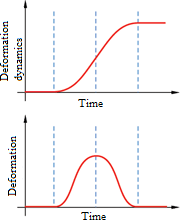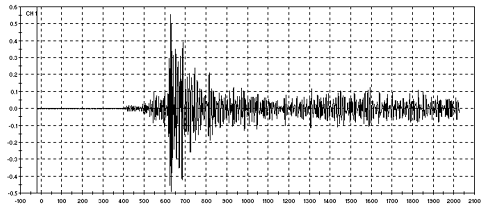Acoustic emission AE
Acoustic emission AE is a process of elastic oscillations (acoustic waves) spreading. The waves are caused by strained material deformation.
Acoustic emission response depends on material structure and deformation process type. Various materials exposed to different strain impacts show variety of acoutic emission properties. There are two factors that cause high emission qualities – frangibility and heterogeneity of the material. Elastic failure processes, for instance, merging of cavities in soft steels, lead to low emission properties (by energy amount and number of signals).
In the figure below you can see simple acoustic source wave example. This wave actually is a tension impulse corresponding to the material surface displacement.

AE wave formed in the acoustic emission source
Wave shift is similar to step function. The tension that corresponds to the displacement value has a pulse shape, width and height of which depends on emission process dynamics. Pulses from such sources as microcracks breakthrough or residual fractions destruction have short duration (less than a microsecond). Acoustic emission primary pulse amplitude and energy can vary in wide range depending on the acoustic emission source. The resulting wave (pulse) is spreading from the source in all directions. Depending on the emission source, the wave can have anisotropic properties (i.e. there may be a dependence of wave speed on direction).
Primary wave shape undergoes considerable changes during wave spread in the material and wave conversion by the sensor. Thus, the signal received from the sensor has only a slight resemblance to the source signal. The figure below shows standard acoustic emission AE signal.

Standard AE signal
This change of acoustic emission shape is a serious problem that we face both in the course of source function research and practical non-destructive control tasks. The scientists that want to determine initial signal shape, use broad-band sensors and perform a detailed analysis of registered signal primary section. This is a crucial and complicated research process, since processing of a single signal may take a lot time. Due to this fact many scientists that are involved in materials testing and NDT research are interested in acoustic emission parameters statistical evaluation rather than in research of separate emission sources characteristics. They are using narrow-band instruments allowing to analyze only several signal forms parameters, however, such instruments allow to register large signal flows (i.e. hundreds of signals per second).
